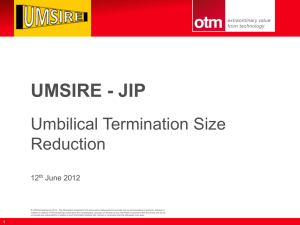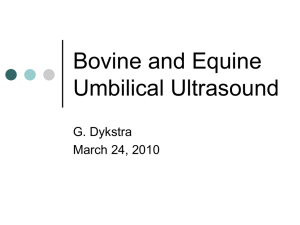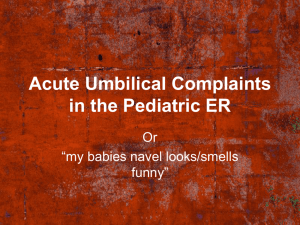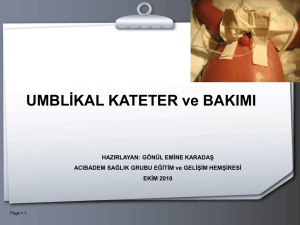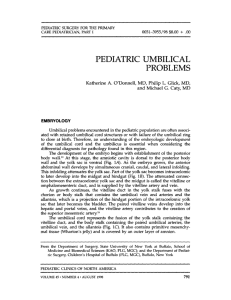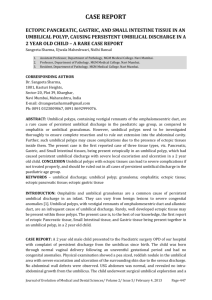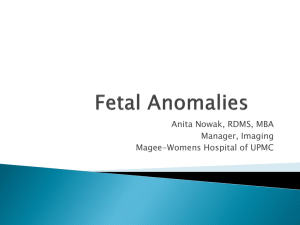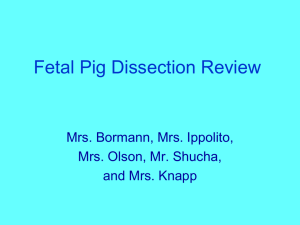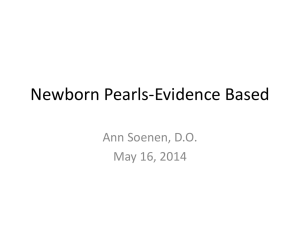Pediatric Umbilical Abnormalities
advertisement
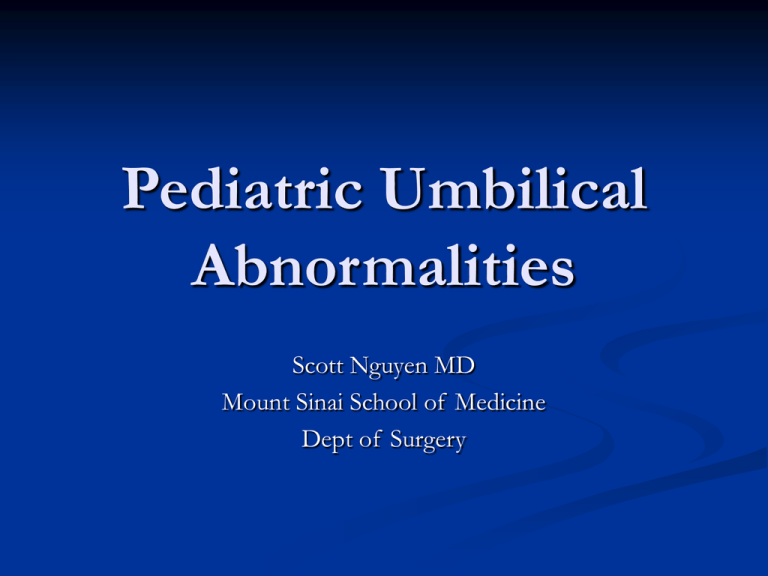
Pediatric Umbilical Abnormalities Scott Nguyen MD Mount Sinai School of Medicine Dept of Surgery Abnormalities of Umbilical Cord Umbilical abnormalities result from failure of umbilical ring to close or persistence of umbilical structures Understanding embryology of cord is essential in understanding the pathophysiology of umbilical abnormalities Embryology - rd 3 week Embryology Embrology Embryology 6th wk – midgut loop elongates and herniates out through umbilical cord Midgut rotates 270 degrees Returns to abdomen by 10th wk Anterior abdominal wall progressively closes leaving only umbilical ring Umbilical Abnormalities Urachal Abnormalities Vitelline Duct Abnormalities Umbilical Hernia Omphalitis Delayed Cord Separation Umbilical granuloma Urachal formation Bladder forms from ventral portion of cloaca Bladder descends into pelvis w/ urachus connecting apex to umbilicus Usually urachus involutes to a fibrous cord – median umbilical ligament Urachal abnormalities • • • • failure of obliteration of urachus resulting complete or partial patency of urachus < 1/1000 live births inflammation or drainage from umbilicus US, CT, contrast studies, or injection of dye into tract can confirm diagnosis • • • • Patent Urachus (50%) Urachal cyst (30%) Urachal sinus (15%) Vesicourachal diverticulum (5%) Patent Urachus Studies Catherization of tract and injection of dye Voiding cystourethrogram US Ultrasound CT VCUG Treatment Patent Urachus Patent Urachus Urachal Cyst Usually assx until infected Rarely become infected in newborn period, usu manifests as young adult Infected Urachal cyst Fever, voiding symptoms, midline hypogastric tenderness, mass, UTI May drain into bladder or umbilicus Rarely can rupture into preperitoneal tissues or peritoneal cavity Cultures - Staph Aureus US CT Infected Urachal cyst - treatment Incision and drainage Percutaneous drainage Complete surgical excision of all urachal tissue 30% recurrence if only drainage Staged approach limits amount of bladder resected Urachal Sinus Becomes symptomatic when infected Tx – drainage and resection of urachal tissue Sinogram Urachal Diverticulum Blind sac at bladder apex Mostly assx Urachal Diverticulum Vitelline Duct Abnormalities Vitelline Duct Vitelline Duct is connection between midgut and yolk sac Usually involutes in 7th – 9th weeks Vitelline duct abnormalities Meckel’s Diverticulum Meckel’s Diverticulum contains ectopic gastric or pancreatic mucosa In 2% of population 2 feet from ileocecal valve, antimesenteric border Majority of symptomatic < 2yrs old Presentation Painless GI Bleeding (50%) Bowel Obstruction (30%) Inflammation – diverticulitis (20%) GI Bleeding Most common cause of bleeding in children Painless, massive, usually self resolving Due to mucosal ulceration from acid secretion Meckel’s Scan – GI bleeding Bowel Obstruction Due to intussusception, diverticulum is the lead point Sudden severe pain out of proportion to physical exam Hydrostatic Barium enema diagnostic, rarely therapeutic Intussusception Intussusseption Meckel’s Diverticulitis Sx like appendicitis Result of lumenal obstruction, bacterial invasion, progressive inflammation Ectopic gastric mucosa predisposes 30% incidence of perforations Higher risk of peritonitis Treatment Surgical Resection without removal of ileum V shaped incision at base resection of involved segment of ileum w/ primary anastamosis Fibrous Vitelline Remnant Fibrous Vitelline Remnant Barium Enema Vitelline Umbilical Fistula Vitelline Umbilical fistula Umbilical polyp May drain enteric contents Fistulogram shows communication w/ bowel Herniation Umbilical Hernia Umbilical hernia Protrudes Rarely incarcerates Incidence 10-25% infants 6-10x higher incidence in Black infants More in girls, premature Assoc w/ Down’s Synd, BeckwithWiedemann synd, hypothyroidism, mucopolysaccharidosis Treatment Most close by 3-4 years age (>90%) Defect greater than 1.5 – 2 cm less likely to close Surgical closure indicated in kids >5 years age Proboscoid Umbilical Hernias Proboscoid umbilical hernias 15-20% of umbilical hernias Same sized fascial defect Same likelihood of closing spontaneously Excessive redundant umbilical skin Surgical repair for social and cosmetic reasons Omphalitis Omphalitis erythema and edema of umbilical area excellent medium for bacterial colonization poor hygiene or hospital-acquired infection Staphylococcus, Streptococcus, Gram (-) rods Treatment IV Antibiotics Local cleaning w/ Etoh Can rapidly progress to Necrotizing fasciitis (16%) Usually polymicrobial Rapidly fatal (50%) Surgical debridement necessary Delayed Cord Separation Separation > 3 wks may be associated w/ an immune deficiency Normal separation via leukocyte infiltration, subsequent necrosis Inherited malfunction of neutrophil, monocyte, or natural killer cells Susceptible to severe bacterial infections Immunologic workup Leukocyte Adhesion Deficiency Deficiency of phagocyte surface Ag – CR3 Cell surface proteins responsible for phagocyte adhesion to endothelium Inability to egress from circulation to areas of inflammation Phagocytic activity, degranulaton, and oxidative metabolism also affected Thank You!!!


